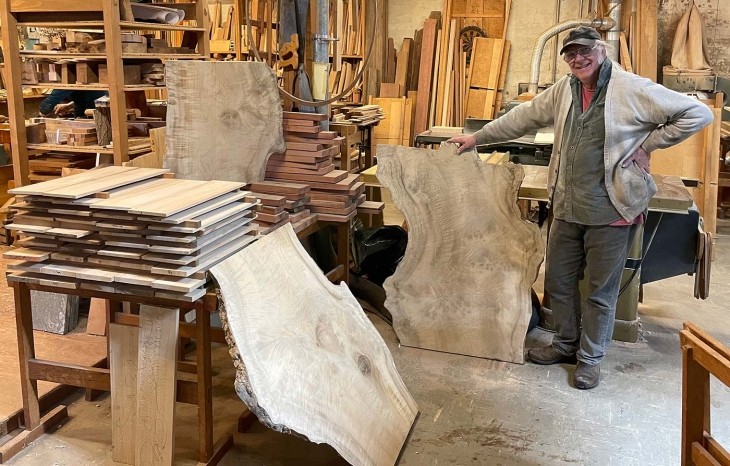After nearly a half century of making finely crafted studio furniture, Hank Gilpin has learned one simple truth: There is no bad wood.
The master craftsman has produced more than 4,000 pieces of highly prized, one-of-a-kind furniture using what commercial furniture producers generally consider “throwaway” wood from “trash” trees. Gilpin’s pieces crafted from this underutilized wood are found in the collections of museums, private collectors, and celebrities, as well as in the homes of regular folks who love and appreciate the beauty of fine studio furniture.
Woodworking was not Gilpin’s first career choice. After graduating from Boston University with a degree in photojournalism, he served in Vietnam as an army photographer. He returned home to attend a photography master’s program at Rhode Island School of Design (RISD). A random choice of electives there led Gilpin to woodworking, which was being taught by Tage Frid, a designer and furniture maker who influenced the development of the studio furniture movement in the United States. Frid would later become Gilpin’s mentor.
After graduating from RISD, Gilpin opened his shop in 1973 when studio furniture makers favored expensive imported wood such as teak, rosewood, and mahogany. A lack of financial resources forced Gilpin to look outside the box for affordable materials.
“My love of throwaway tree species began not from an aesthetic intent, but from a practical need,” said Gilpin, 75, who lives in Rhode Island in the converted wooden church he bought when he was 26 years old. “I simply couldn’t afford imported wood. This led me from the lumberyard to the sawmill to find inexpensive wood.”
While cherry, oak, and maple are the preferred domestic tree species used for high-volume furniture – primarily because they are found in large stands within a woodlot – Gilpin said there are many other native species that can be used for woodworking.
“I wanted to find out where the wood came from, so I went into the forest,” Gilpin said. “When I saw all the different tree species, it blew my mind. The forest isn’t made of whole stands of oak, maple, or cherry. There’s an endless array of species among the more commercially viable trees. For me that meant unlimited opportunities.”
His artistic eye allowed Gilpin to see the intrinsic beauty and potential in what many in the wood industry regard as “trash” trees. For example, quarter sawn sycamore has eye-popping dynamic grain; the wood of Osage orange, an ornamental tree, is a beautiful lemon-yellow when it is first worked, but a year later it turns a gorgeous cinnamon-brown. If a plant has a woody stem, it has potential in his shop. He even uses smaller diameter wood from the invasive common barberry, a shrub with chromium yellow wood, and even purple striated lilac for drawer pulls and handles. Imperfections are considered not as obstacles but as exciting opportunities that challenge Gilpin’s creativity and woodworking skills. “Even knots and crotches can make something beautiful,” explained Gilpin, who has written articles for Fine Woodworking magazine. “Any wood can be used.”
Gilpin begins his design process in the reverse of what is most common. “I don’t start the design on paper,” he said. “I have to see the wood in front of me.” Like a sculptor he studies the wood to reveal its intrinsic qualities and its potential. In his design’s conception Gilpin considers the wood’s grain, color, texture, shape, size, and qualities for his finished product.
For many years Gilpin acquired most of his wood from sawmills in Ohio, where many of the underutilized woods were set aside for him in a “Hank pile.” Gilpin would purchase two tractor-trailer loads of lumber each year and truck them to his shop, where he air dries wood before fashioning it into furniture. He employs basic machinery, such as a table saw, mortiser, and drill press, but uses mostly hand tools.
Gilpin believes that his commitment to throwaway wood has offered those trees “a better end.” And his work serves as proof of that old saw, “One man’s trash is another man’s treasure.”
You can see more examples of his work here.






Discussion *